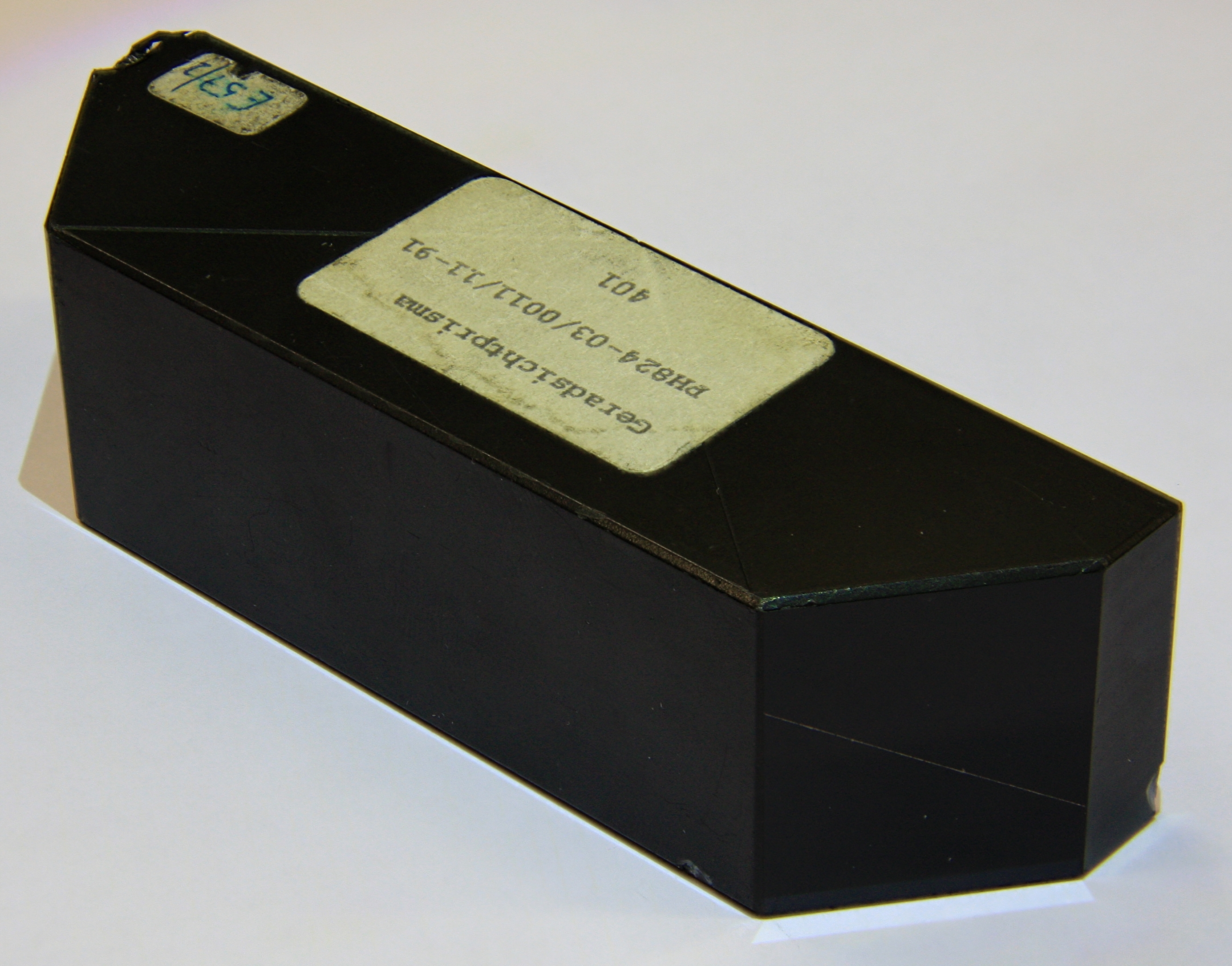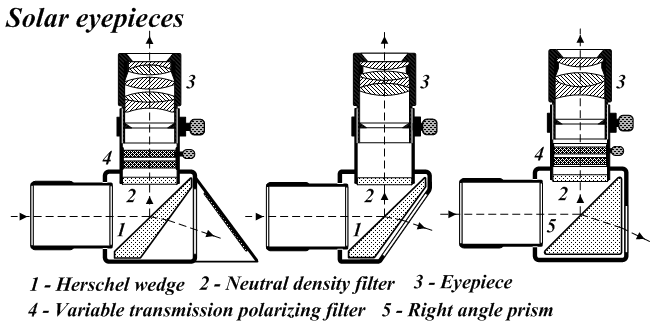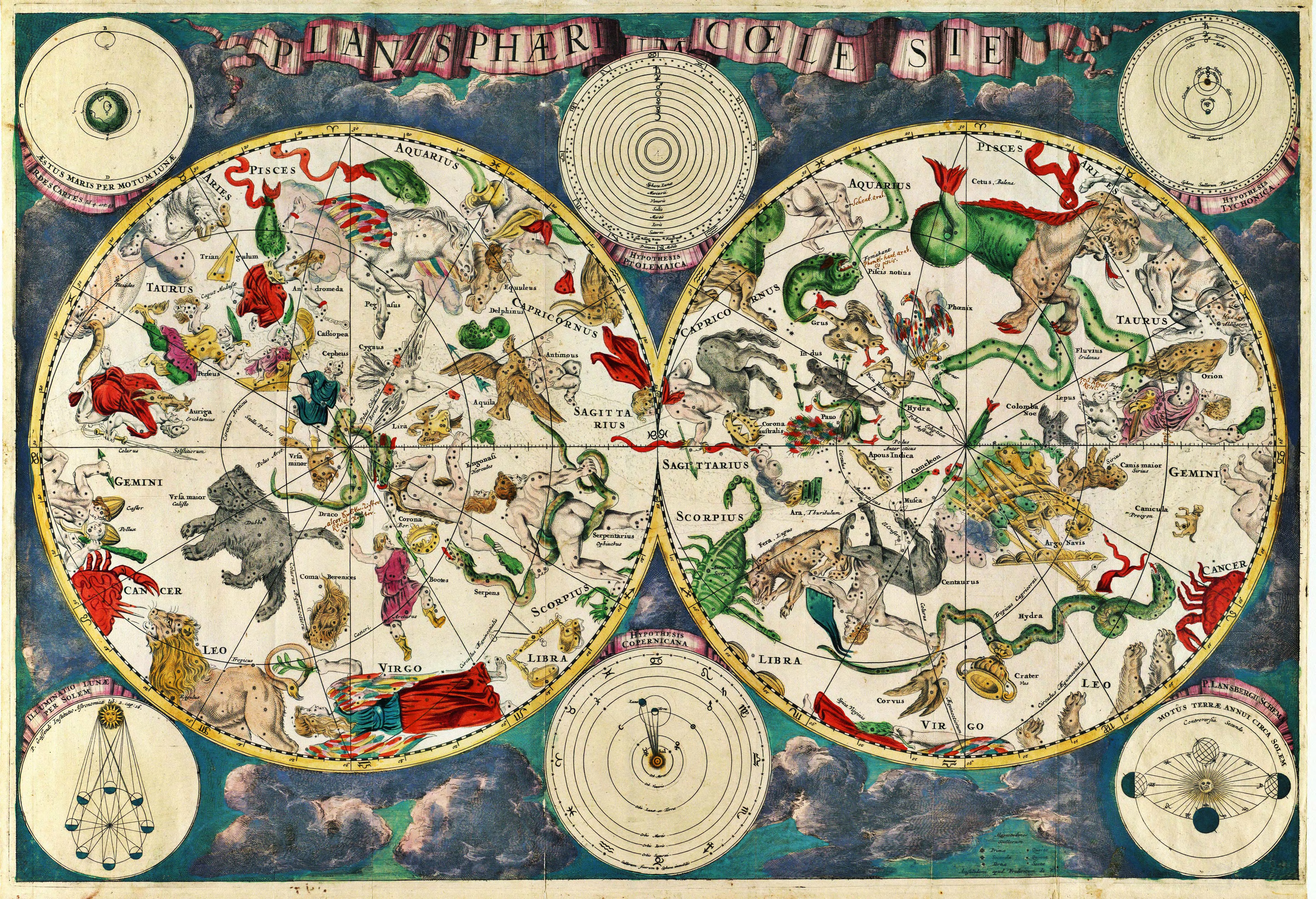|
Star Diagonal
A star diagonal, erecting lens or diagonal mirror is an angled mirror or prism used in telescopes that allows viewing from a direction that is perpendicular to the usual eyepiece axis. It allows more convenient and comfortable viewing when the telescope is pointed at, or near the zenith (i.e. directly overhead). Also, the resulting image is right side up, but is reversed from left to right. Types of diagonals Star diagonals are available in 0.965", 1.25", and 2" diameters. The 2" diagonals allow longer-focal length, low-power 2" barrel eyepieces for a wider field of view. Star diagonals come in all price ranges, from as low as a few dollars up to hundreds of dollars. Mirror (reflective) diagonals These diagonals (often called star diagonals) use a mirror set at a 45° angle inside the diagonal to turn the telescope's image at a 90° angle to the rear cell. Mirror diagonals produce an image in the eyepiece that is correctly oriented vertically, but is reversed left-to-right hori ... [...More Info...] [...Related Items...] OR: [Wikipedia] [Google] [Baidu] |
Telescope
A telescope is a device used to observe distant objects by their emission, absorption, or reflection of electromagnetic radiation. Originally meaning only an optical instrument using lenses, curved mirrors, or a combination of both to observe distant objects, the word ''telescope'' now refers to a wide range of instruments capable of detecting different regions of the electromagnetic spectrum, and in some cases other types of detectors. The first known practical telescopes were refracting telescopes with glass lenses and were invented in the Netherlands at the beginning of the 17th century. They were used for both terrestrial applications and astronomy. The reflecting telescope, which uses mirrors to collect and focus light, was invented within a few decades of the first refracting telescope. In the 20th century, many new types of telescopes were invented, including radio telescopes in the 1930s and infrared telescopes in the 1960s. Etymology The word ''telescope'' was coin ... [...More Info...] [...Related Items...] OR: [Wikipedia] [Google] [Baidu] |
Objective (optics)
In optical engineering, the objective is the optical element that gathers light from the object being observed and focuses the light rays to produce a real image. Objectives can be a single lens or mirror, or combinations of several optical elements. They are used in microscopes, binoculars, telescopes, cameras, slide projectors, CD players and many other optical instruments. Objectives are also called object lenses, object glasses, or objective glasses. Microscope objectives The objective lens of a microscope is the one at the bottom near the sample. At its simplest, it is a very high-powered magnifying glass, with very short focal length. This is brought very close to the specimen being examined so that the light from the specimen comes to a focus inside the microscope tube. The objective itself is usually a cylinder containing one or more lenses that are typically made of glass; its function is to collect light from the sample. Magnification One of the most important prope ... [...More Info...] [...Related Items...] OR: [Wikipedia] [Google] [Baidu] |
Amici Prism
An Amici prism, named for the astronomer Giovanni Battista Amici, is a type of compound dispersive prism used in spectrometers. The Amici prism consists of two triangular prisms in contact, with the first typically being made from a medium-dispersion crown glass, and the second a higher-dispersion flint glass. Light entering the first prism is refracted at the first air-glass interface, refracted again at the interface between the two prisms, and then exits the second prism at near-normal incidence. The prism angles and materials are chosen such that one wavelength (colour) of light, the ''centre wavelength'', exits the prism parallel to (but offset from) the entrance beam. The prism assembly is thus a ''direct-vision prism'', and is commonly used as such in hand-held spectroscopes. Other wavelengths are deflected at angles depending on the glass dispersion of the materials. Looking at a light source through the prism thus shows the optical spectrum of the source. By 1860, Am ... [...More Info...] [...Related Items...] OR: [Wikipedia] [Google] [Baidu] |
Herschel Wedge
A Herschel wedge or Herschel prism is an optical prism used in solar observation to refract most of the light out of the optical path, allowing safe visual observation. It was first proposed and used by astronomer John Herschel in the 1830s. Overview The prism in a Herschel wedge has a trapezoidal cross section. The surface of the prism facing the light acts as a standard diagonal mirror, reflecting a small portion of the incoming light at 90 degrees into the eyepiece. The trapezoidal prism shape refracts the remainder of the light gathered by the telescope's objective away at an angle. The Herschel wedge reflects about 4.6% of the light that passes through one of the prism faces that is flat to 1/10 of the wavelength of the light. The remaining ~95.4% of the light and heat goes into the prism and exits through the other face and out the back door of the housing; thus, the excess light and heat is disposed of and not used for observing. While they decrease the intensity of the lig ... [...More Info...] [...Related Items...] OR: [Wikipedia] [Google] [Baidu] |
Spotting Scope
A spotting scope is a compact high-power telescope optimized for detailed observation of distant objects. They are used as portable optical enhancement devices for various outdoor activities such as birdwatching, skygazing and other naturalist activities, for hunting and target shooting to verify a marksman's shot placements, for tactical ranging and surveillance, and for any other application that requires higher magnification than ordinary binoculars (typically 20× to 60×). The light-gathering power and resolution of a spotting scope is determined by the diameter of the objective lens, typically between . The larger the objective, the more massive and expensive the telescope. The optical assembly has a small refracting objective lens, an internal image-erecting system, and an eyepiece that is usually removable. The image-erecting system may use relay lenses, prisms such as Porro or roof prisms, or a catadioptric system of the Schmidt or Maksutov design. Spotting ... [...More Info...] [...Related Items...] OR: [Wikipedia] [Google] [Baidu] |
Star Chart
A star chart is a celestial map of the night sky with astronomical objects laid out on a grid system. They are used to identify and locate constellations, stars, nebulae, galaxies, and planets. They have been used for human navigation since time immemorial. Note that a star chart differs from an astronomical catalog, which is a listing or tabulation of astronomical objects for a particular purpose. Tools utilizing a star chart include the astrolabe and planisphere. History Prehistory A variety of archaeological sites and artifacts found are thought to indicate ancient made star charts. The oldest known star chart may be a carved ivory Mammoth tusk, drawn by early people from Asia who moved into Europe, that was discovered in Germany in 1979. This artifact is 32,500 years old and has a carving that resembles the constellation Orion, although it could not be confirmed and could also be a pregnancy chart. German researcher Dr Michael Rappenglueck, of the University of M ... [...More Info...] [...Related Items...] OR: [Wikipedia] [Google] [Baidu] |
Roof Prism
A roof prism, also called a Dachkanten prism or Dach prism (from German: ''Dachkante'', lit. "roof edge"), is a reflective prism containing a section where two faces meet at a 90° angle, resembling the roof of a building and thus the name. Reflection from the two 90° faces returns an image that is flipped laterally across the axis where the faces meet. Characteristic for a roof prism is that the beam is split in half, with one half of the beam hitting first one face then the other face, while it is invert for the other half of the beam. Therefore, a roof prism can be used only with some distance to focal planes, or the "edge" of the roof would introduce slight distortions. Furthermore, the angle between the two faces has to be very close to 90°, or image quality would be degraded. The simplest roof prism is the Amici roof prism, with other common roof prism designs being the Abbe–Koenig prism, the Schmidt–Pechan prism and probably the best known being the roof pentapr ... [...More Info...] [...Related Items...] OR: [Wikipedia] [Google] [Baidu] |
Maksutov Telescope
The Maksutov (also called a "Mak") is a catadioptric telescope design that combines a spherical mirror with a weakly negative meniscus lens in a design that takes advantage of all the surfaces being nearly "spherically symmetrical". The negative lens is usually full diameter and placed at the entrance pupil of the telescope (commonly called a "corrector plate" or "meniscus corrector shell"). The design corrects the problems of off-axis aberrations such as coma found in reflecting telescopes while also correcting chromatic aberration. It was patented in 1941 by Russian optician Dmitri Dmitrievich Maksutov. Maksutov based his design on the idea behind the Schmidt camera of using the spherical errors of a negative lens to correct the opposite errors in a spherical primary mirror. The design is most commonly seen in a Cassegrain variation, with an integrated secondary, that can use all-spherical elements, thereby simplifying fabrication. Maksutov telescopes have been sold on the ama ... [...More Info...] [...Related Items...] OR: [Wikipedia] [Google] [Baidu] |
Chromatic Aberration
In optics, chromatic aberration (CA), also called chromatic distortion and spherochromatism, is a failure of a lens to focus all colors to the same point. It is caused by dispersion: the refractive index of the lens elements varies with the wavelength of light. The refractive index of most transparent materials decreases with increasing wavelength. Since the focal length of a lens depends on the refractive index, this variation in refractive index affects focusing. Chromatic aberration manifests itself as "fringes" of color along boundaries that separate dark and bright parts of the image. Types There are two types of chromatic aberration: ''axial'' (''longitudinal''), and ''transverse'' (''lateral''). Axial aberration occurs when different wavelengths of light are focused at different distances from the lens (focus ''shift''). Longitudinal aberration is typical at long focal lengths. Transverse aberration occurs when different wavelengths are focused at different positions i ... [...More Info...] [...Related Items...] OR: [Wikipedia] [Google] [Baidu] |
Dispersion (optics)
In optics, and by analogy other branches of physics dealing with wave propagation, dispersion is the phenomenon in which the phase velocity of a wave depends on its frequency; sometimes the term chromatic dispersion is used for specificity to optics in particular. A medium having this common property may be termed a dispersive medium (plural ''dispersive media''). Although the term is used in the field of optics to describe light and other electromagnetic waves, dispersion in the same sense can apply to any sort of wave motion such as acoustic dispersion in the case of sound and seismic waves, and in gravity waves (ocean waves). Within optics, dispersion is a property of telecommunication signals along transmission lines (such as microwaves in coaxial cable) or the pulses of light in optical fiber. Physically, dispersion translates in a loss of kinetic energy through absorption. In optics, one important and familiar consequence of dispersion is the change in the angle of refra ... [...More Info...] [...Related Items...] OR: [Wikipedia] [Google] [Baidu] |
Zenith
The zenith (, ) is an imaginary point directly "above" a particular location, on the celestial sphere. "Above" means in the vertical direction (plumb line) opposite to the gravity direction at that location (nadir). The zenith is the "highest" point on the celestial sphere. Origin The word "zenith" derives from an inaccurate reading of the Arabic expression (), meaning "direction of the head" or "path above the head", by Medieval Latin scribes in the Middle Ages (during the 14th century), possibly through Old Spanish. It was reduced to "samt" ("direction") and miswritten as "senit"/"cenit", the "m" being misread as "ni". Through the Old French "cenith", "zenith" first appeared in the 17th century. Relevance and use The term ''zenith'' sometimes means the highest point, way, or level reached by a celestial body on its daily apparent path around a given point of observation. This sense of the word is often used to describe the position of the Sun ("The sun reached its zenit ... [...More Info...] [...Related Items...] OR: [Wikipedia] [Google] [Baidu] |








.jpg)
